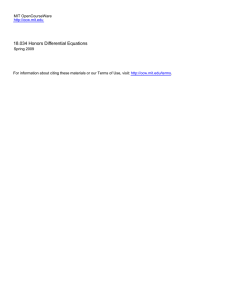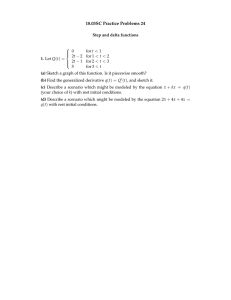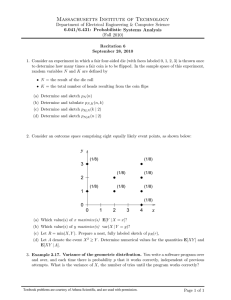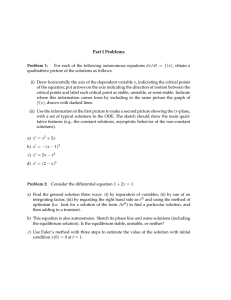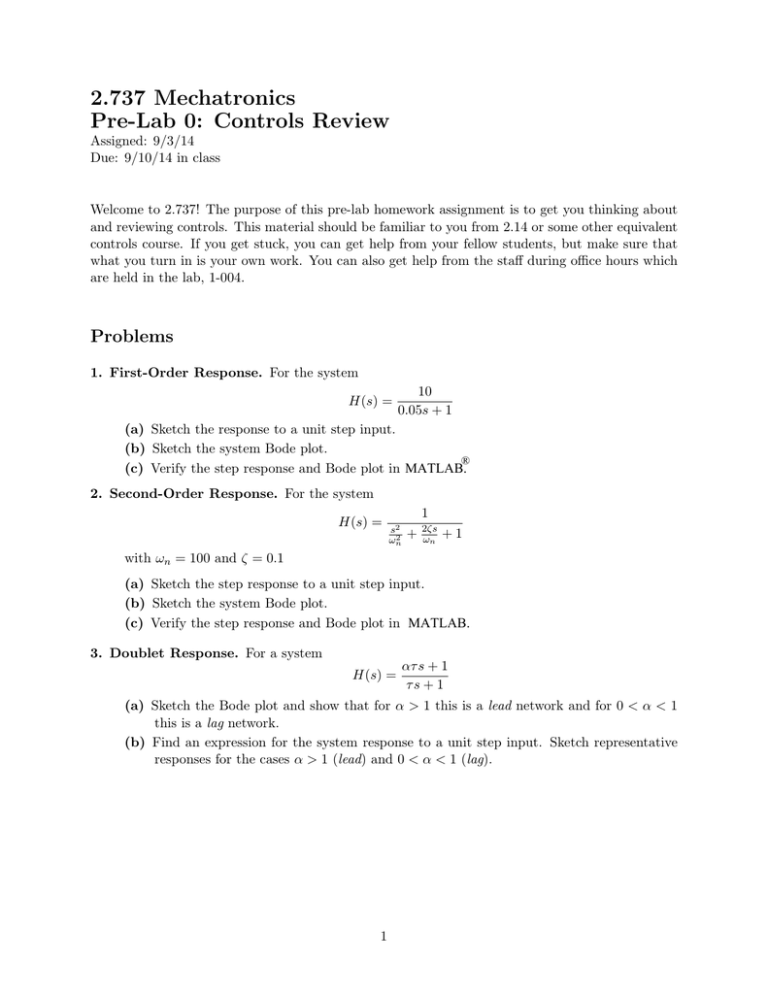
2.737 Mechatronics
Pre-Lab 0: Controls Review
Assigned: 9/3/14
Due: 9/10/14 in class
Welcome to 2.737! The purpose of this pre-lab homework assignment is to get you thinking about
and reviewing controls. This material should be familiar to you from 2.14 or some other equivalent
controls course. If you get stuck, you can get help from your fellow students, but make sure that
what you turn in is your own work. You can also get help from the staff during office hours which
are held in the lab, 1-004.
Problems
1. First-Order Response. For the system
H(s) =
10
0.05s + 1
(a) Sketch the response to a unit step input.
(b) Sketch the system Bode plot.
®
(c) Verify the step response and Bode plot in MATLAB.
2. Second-Order Response. For the system
H(s) =
1
s2
2
ωn
+
2ζs
ωn
+1
with ωn = 100 and ζ = 0.1
(a) Sketch the step response to a unit step input.
(b) Sketch the system Bode plot.
(c) Verify the step response and Bode plot in MATLAB.
3. Doublet Response. For a system
H(s) =
ατ s + 1
τs + 1
(a) Sketch the Bode plot and show that for α > 1 this is a lead network and for 0 < α < 1
this is a lag network.
(b) Find an expression for the system response to a unit step input. Sketch representative
responses for the cases α > 1 (lead) and 0 < α < 1 (lag).
1
4. Block Diagram. (This problem is taken from Roberge, J.K., Operational Amplifiers: Theory
and Practice, Wiley, 1976.) Figure 2.20 shows a block diagram for a linear feedback system.
Write a complete, independent set of equations for the relationships implied by this diagram.
Solve your set of equations to determine the input-to-output gain of the system.
© John Wiley & Sons. All rights reserved. This content is excluded from our Creative Commons license.
For more information, see http://ocw.mit.edu/help/faq-fair-use/..
5. Nonlinear Feedback. (This problem is taken from Roberge, J.K., Operational Amplifiers:
Theory and Practice, Wiley, 1976.) Plot the closed-loop transfer characteristics for the non­
linear system shown in Fig. 2.22.
© John Wiley & Sons. All rights reserved. This content is excluded from our Creative Commons license.
For more information, see http://ocw.mit.edu/help/faq-fair-use/..
2
6. Servomechanism with Disturbance. For the servomechanism of Fig. 1.18 let the parame­
ters be
JT
= 10−5 kg · m2
B = 10−3 N · m · s/rad
Km = 0.1 N · m/A
Kt = 2 V/rad
Note that the amplifier with gain Ka is a current-drive which determines the motor current
Im directly. Thus in this model, the motor back emf does not affect the dynamics. The motor
torque is given by Tm = Km Im .
This system can be represented by the block diagram as shown in Figure 1.19. (Note: There
should not be gaps near the summing junction and output in Figure 1.19.)
(a) Choose gain Ka to yield a system with a step-response peak overshoot of 20% for an
input Vi and output θ . What is the resulting damping ratio ζ and natural frequency,
ωn ?
(b) Calculate the disturbance transfer function
fected by varying Ka ?
Θ(s)
Td (s) .
How is the disturbance rejection af­
(c) Sketch a root locus for this system as Ka varies between 0 and ∞. How is stability
affected with increasing Ka ?
(d) Verify your root locus in MATLAB.
(e) For the value of Ka found in part (a), determine an analytical expression for the loop
return ratio transfer function. Make a sketch of the Bode plot for this return ratio. What
are the loop crossover frequency and phase margin? Be sure to indicate these values on
the Bode plot.
(f ) Conduct a Nyquist analysis and make a sketch of the Nyquist plot for this loop. Is the
loop stable? Why or why not? Show how the crossover frequency and phase margin are
represented on this loop.
3
4
5
7. Op amp circuit The circuit shown below purports to be an analog computer simulation of a
mass/spring/damper system. In this circuit, all amplifiers are ideal, with infinite gain.
a) Draw a block diagram which represents the circuit, and which includes the variables Vi , i1 , i2 ,
i3 , i4 , V1 , V2 , V3 , and V4 . Expressions in the blocks should be in terms of the given system
parameters.
b) Show that the system can be described by the differential equation
aV¨1 + bV̇1 + cV1 = dVi
where a, b, c, and d are scalar constants. Give expressions for these constants in terms of the
system parameters. Hint: V2 ∝ V̇1 , and V3 ∝ V̇2 ∝ V¨1
6
MIT OpenCourseWare
http://ocw.mit.edu
2.737 Mechatronics
Fall 2014
For information about citing these materials or our Terms of Use, visit: http://ocw.mit.edu/terms.

